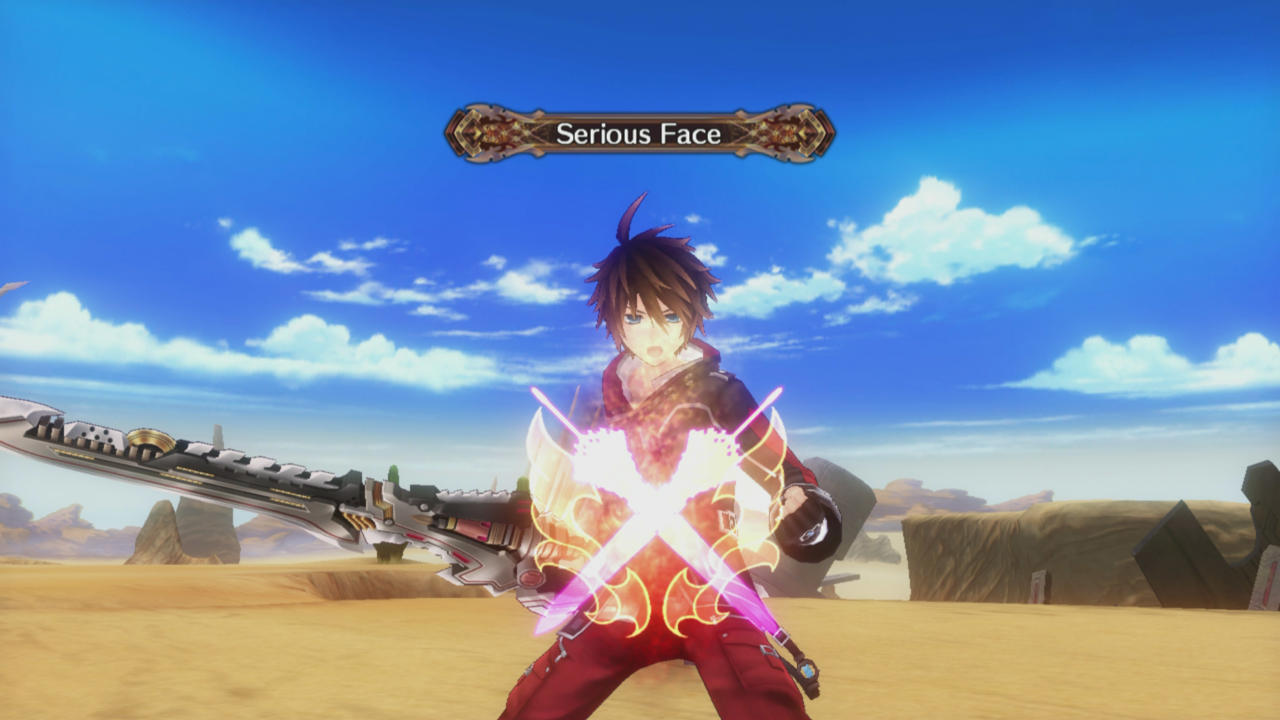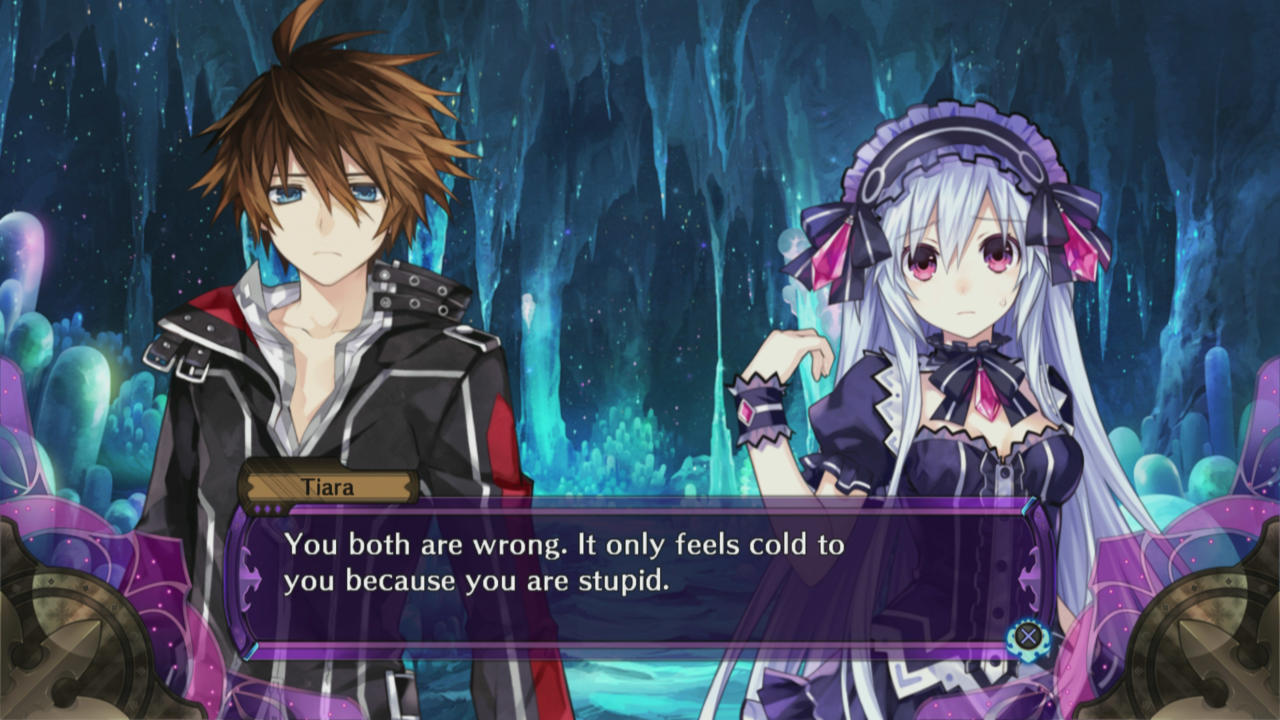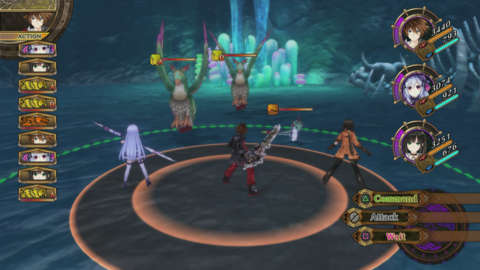Conceptually, Fairy Fencer F would seem to be a return to the roots of the JRPG genre: a traditionally-styled game with a distinctly Japanese story and aesthetic. Consider the alliteration in Fairy Fencer F’s title, which calls Final Fantasy to mind, or the game’s development team, which includes composer Nobuo Uematsu and artist Yoshitaka Amano, both of Final Fantasy fame. How unfortunate, then, that Fairy Fencer F is no glorious return to the heyday of the JRPG, but rather a strange, distorted effort, terrifically fun in bursts but plagued by unfortunate technical issues.
Fairy Fencer F is the story of young warrior Fang and his fairy partner, Eryn. Fang's excessively cynical and derogatory attitude is likely to grate within mere minutes of starting the game, in which he constantly complains about his new path in life. You see, as the game begins, Fang is told by a shopkeeper that if he is capable of pulling out a strange sword embedded in a rock, he will be granted any wish he desires. All he wants is tasty food (a running obsession that becomes unfunny almost instantly), but, upon yanking out the sword, he is greeted by semi-amnesiac Eryn, told he is a legendary fencer, and asked to free the world's Goddess from her stasis by finding and using Furies, fairies trapped in mythical weapons. Fang’s annoyance at having such a burden suddenly dropped on him is understandable, but his continued whininess and apathy is exceptionally irksome. Eryn is more likeable, though the moment another female appears on the scene she goes into (similarly unfunny) jealous-possessive-angry mode.

I soon met Tiara, a stuck-up, bratty fencer who harbors a genre-standard terrible secret. She also doubles as an exposition machine, teaching you about the plane beyond reality where the Goddess and evil deity are sealed and giving you a free inn to recover at--when she's not being bossy and condescending. Notice a theme here? The majority of Fairy Fencer F's cast was ripped straight from the pages of Anime Character Tropes You Can Implement Easily. Suffice to say, it takes a fair amount of time before a truly likeable character joins the troupe. Certain party members become more tolerable as time goes on, but it's hard to shake those awful first impressions.
Saddled with a party of people I would have liked to punch in the face given the opportunity, I ventured out into the exploration portion of Fairy Fencer F. Much to my relief, exploration and combat are a fair bit more energizing than watching barely-animated character cutouts complain to each other. Combat is turn-based with positioning elements: You and your enemies move around a small field and trade blows with each other, launching area-of-effect spells and utilizing strategic positioning to your advantage. The basics aren't tough to grasp, and as you earn more weapon points in battle, you can customize your stat boosts and add multi-hitting combo capabilities to your characters' strikes.

The majority of Fairy Fencer F's cast was ripped straight from the pages of Anime Character Tropes You Can Implement Easily.
A neat addition to the formula is the tension gauge: as characters attack and use skills, their tension increases and multiplies the damage they deal. Once tension reaches a certain point, characters can "fairize," transforming into quasi-robot-armored fighters with access to special, super-damaging techniques. However, playing overly defensively--using lots of healing items and spells, retreating from enemies, running away from battle--reduces the tension, and if it dips below a certain point, your combat efficacy will suffer. It's a neat system that makes the combat considerably more engaging. It's quite fast-paced, as well--the handy L2 button allows you to skip a lot of long-winded combat animations.
You can find new dungeons to explore at set points in the story, where you'll find some Furies to collect (along with the fairies that inhabit them and/or possibly another fencer). Once you've got a Fury/fairy combo, you can summon the pair to remove one of the binding blades sealing the Goddess and the Vile God. Doing so upgrades the abilities of the fairy, who can then either be assigned to one of your party members or to a dungeon via a process called "world shaping." While the stat bonuses fairies can provide to party members are nothing to be sneezed at (and they also level up through combat), world shaping is particularly cool: by assigning a fairy to a dungeon, you also get persistent effects throughout that dungeon, i.e. an experience boost when defeating enemies. This helps make sub-questing less of an out-and-out grind, as it helps tailor some dungeon settings to your liking. The dungeon romping itself is also more engaging than developer Compile Heart's previous endeavors, with multi-level layouts and traps.

As much as I enjoyed the fundamental combat and dungeon-crawling, it was sometimes difficult for me to enjoy them. In many of the dungeons, Fairy Fencer F suffers from an atrocious and varying framerate, frequently dipping into the sub-20 frames-per-second range. Compile Heart games tend to suffer from this problem, even though the visuals aren't terribly complex, but Fairy Fencer F is particularly awful, to the point where dungeon crawls can lead to motion sickness and headaches.
The irritating cast and miserable framerate dips aside, you must also contend with sudden difficulty spikes, recycled environments, and an inconsistent art style. Even the much-touted Yoshitaka Amano and Nobuo Uematsu’s contributions are disappointing. Amano's contributions are a handful of art concepts, while Uematsu's--or more specifically, Uematsu's team of musicians, the Earthbound Papas’--music is uneven; some tracks are absolutely fantastic, while others are entirely unmemorable. Yet there are glimpses of a game that could have been consistently entertaining: combat, when it's not running like a slideshow, is satisfying; there's a lot of customization available to the player; and that butt-rock theme that plays during fairizing is rousing in much the same way Uematsu's Blue Dragon boss music was.
Fairy Fencer F has its bright spots, but it's not a game I can heartily recommend--there's too much detritus to dig through in order to get to the fun bits. Compile Heart has announced a sequel, so here's to hoping the move to more recent hardware will solve their games’ lingering technical problems--and here's to hoping the resulting games will be better as a result.